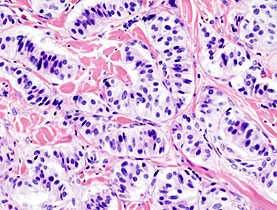
Scientists pinpoint small rare tumours

The search for hard-to-find tumours called insulinomas has been made easier thanks to a discovery by researchers in Bern and Basel.
A new diagnostic procedure developed as a result of the discovery means highly precise operations are now possible. Surgery has already been tested successfully on two patients in Bern.
In a laboratory finding, scientists discovered a way of making the 1-2cm tumours visible using a radioactive molecule which binds itself to a protein that is produced by virtually all insulinomas.
The results of the study are published in the current edition of the New England Journal of Medicine.
“We found in insulinoma tumours taken from patients a very high density of a protein called GPL1 receptor,” Jean Claude Reubi, a professor at the Institute of Pathology at Bern University, told swissinfo.
“But this discovery is significant for patients only if we can translate it into a clinical application. We have tried to translate it into a diagnostic tool and method in collaboration with our colleagues at the Nuclear Medicine Institute at Basel.”
Reubi explained how they designed and developed a radioactive tool that would act precisely on the GPL1 receptor. When it was injected into the patient, they could localise the tumour precisely.
“Niche discovery”
However, Reubi added a few words of caution.
“We have to understand that an insulinoma is a rare tumour. It is present in about four new diagnosed cases per million inhabitants per year,” he said.
“In addition, in a significant number of these cases the tumour can be localised with conventional methods. But in about a third of cases it really is a challenge diagnosing the tumours. For these people this discovery is very significant. It is a niche discovery and a niche method – at least at the moment.”
Reubi explained why the discovery was big news for this small group of people.
“First of all insulinomas are dangerous tumours. They secrete large amounts of insulin in a completely unregulated way, with the consequence that the blood glucose can reach dangerously low levels. This can lead to a loss of consciousness, central nervous system disturbances – it can even lead to death, despite the fact that these insulinomas are very small,” he said.
Optimal planning
Because of this danger, the insulinomas need to be surgically removed – “and of course the surgeon needs to know where the tumour is located”.
Reubi points out that this new method allows the tumour to be localised before the surgical intervention. The surgeon can see on the scan where the tumour is, how big it is, whether there is more than one and they can make an optimal planning of the operation accordingly.
Two patients at the Inselspital, the university hospital in Bern, have already benefited from the procedure.
“Another advantage is that the method enables localisation of the tumour during surgery, because the tumour has a radioactive signal which we can identify with a so-called probe, which is like a pen. This detects radioactivity in small spots,” Reubi said.
“For the patient, this means a shorter, more precise operation and better chances of a cure.”
swissinfo, Thomas Stephens
Insulinomas – small tumours of the pancreas that produce excessive amounts of insulin – are very hard to locate using conventional imaging methods. More than 90 per cent of all insulinomas are benign (non-cancerous).
Excessive amounts of insulin causes low blood sugar (hypoglycemia). Typical symptoms are related to the development of low blood sugar and include hunger, headaches, lethargy, double and blurred vision, particularly with exercise or fasting. Many patients have to eat frequently to prevent symptoms from the low blood sugar. Some patients may develop psychiatric symptoms because of the low blood sugar.
Severe hypoglycemia may result in seizures, coma and permanent neurological damage. Sudden and dramatic weight gain is sometimes seen.
The definitive treatment is surgical removal of the insulinoma. This may involve removing part of the pancreas as well. Medications such as diazoxide and somatostatin can be used to block the release of insulin for patients who are not surgical candidates or who otherwise have inoperable tumours.

In compliance with the JTI standards
More: SWI swissinfo.ch certified by the Journalism Trust Initiative




























You can find an overview of ongoing debates with our journalists here . Please join us!
If you want to start a conversation about a topic raised in this article or want to report factual errors, email us at english@swissinfo.ch.